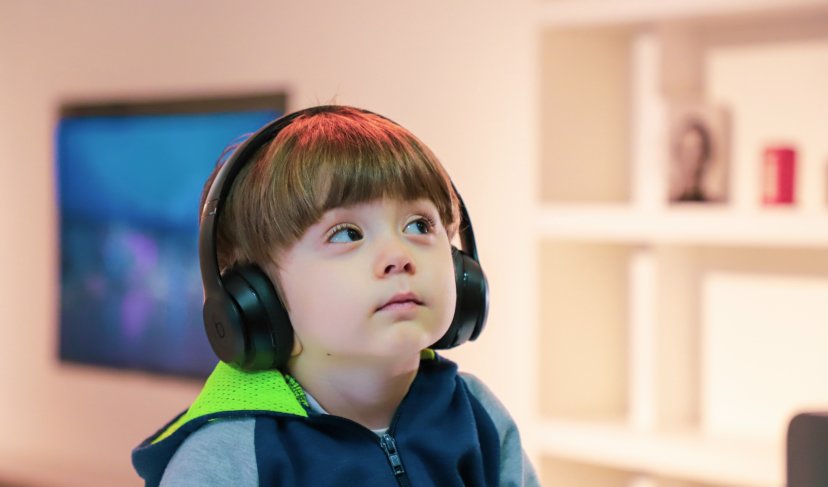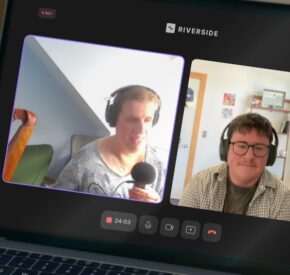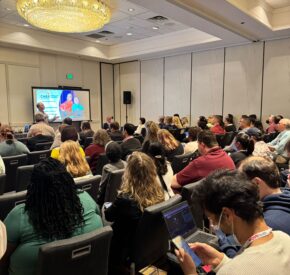The Ideal School
Article 19 explores inclusive education and remote learning accessibility

In this episode, Megan Roper, an art teacher at The Ideal School of Manhattan, New York City discusses how inclusion is central to her work. The Ideal School is an independent inclusion school that was founded by parents of children with disabilities with dreams of creating inclusive education for all. This small school consists of students with disabilities achieving education goals alongside peers of all abilities. Teachers such as Megan rely on a method known as the choice-based method. This method assumes children as the artist. The educator provides them with the necessary tools to build an art design and the student uses their own imagination to create their WOW (wonderful, original work) projects. When children are viewed as the central innovators, projects are valued more by the entire class despite different capabilities.
Just as digital accessibility prioritizes all users as central to design, the Ideal School’s inclusive approach puts students at the heart of the learning process. Tune in to hear this inspiring disability advocate and talented art teacher discuss her passion for inclusive education and her innovative strategies for transitioning to remote learning while ensuring equal access for all students.
Meet our guests:
- Megan Roper is a passionate arts educator and the Coordinator of Student Life and Leadership at The Ideal School of Manhattan. With over a decade of experience in NYC schools, she’s dedicated to empowering students and fostering creativity.
Listen to more Article 19 Podcast Episodes
Full Transcript
Access the PDF Transcript
Voiceover:
Expression is one of the most powerful tools we have. A voice, a pen, a keyboard.
The real change, which must give to people throughout the world their human rights, must come about in the hearts of people. We must want our fellow human beings to have rights and freedoms, which give them dignity.
Article 19 is the voice in the room.
Marty:
Hello and welcome to Article 19. My name is Marty Molloy, chief of staff and catalyst at Tamman, and I will be the host for our conversation today. I am joined by my cohosts Amanda Roper, program manager of Tamman’s accessibility initiatives.
Amanda:
Hello.
Marty:
And Michael Mangos, CEO and Co-founder of Tamman.
Mike:
Hello, Mr. Molloy.
Marty:
This episode today, we’re going to be joined by Megan Roper, an art teacher at the IDEAL School in Manhattan, New York City. IDEAL is New York’s only K to 12 independent inclusion school. Megan is here to share her insights and thoughts around in-person and online accessibility when it comes to teaching, engagement, and art. Before we begin, I’d like to remind everyone that this podcast is a call for others to join in a bigger conversation with us. At Tamman, we are building the inclusive web, but we can’t do that alone. To do it, we need all of us working together, learning together to do this. Thanks for listening, and let’s get the conversation started. Let me bring in, formally, Amanda, Mike, and Megan. Hi there, everybody. How’s everybody feeling today?
Megan:
Hi.
Amanda:
Hello.
Mike:
Doing great.
Megan:
Pretty great.
Marty:
Did everyone have as long a day as I have, as we are recording this towards the end of our day?
Megan:
I’m definitely a little tired, but I’m excited to be here.
Marty:
We’re excited to have you. Mike and Amanda, how are you guys feeling?
Amanda:
I’m feeling pretty good. It’s awesome having Megan here with us. A little bit odd to see your face on the screen in addition to Mike and Marty, and Mark.
Marty:
Why is that, Amanda?
Amanda:
That’s a great question, and I wasn’t sure if we were going to be covering this in the intro, but here we are covering this in the intro. Megan is my big sister, and she has been my whole life.
Marty:
Mike, what’s going on, Man? [crosstalk 00:02:20]
Mike:
I’m doing great. 10 and a half hours into a workday, no breaks. Started the day without any heat, finished the day with heat, so that’s great.
Marty:
Always a good thing. Amanda, I was hoping that you could start us off with an opening, easy question.
Amanda:
As we are recording at the end of a workday, here is an easy question to transition, get our brains revved up. Are you ready?
Megan:
Ready.
Marty:
Ready.
Amanda:
Thinking about education, but frankly, for all of us, what do you do, or would you like to do, when you see someone fading on Zoom call?
Megan:
This is a good one, and I would say this is probably one of the oldest teacher tricks in the book. It’s called a cold call, and it’s literally when you just say the person’s name and you just call them out, like, “Amanda, you OK? I see you over there. How’s it going?” That’s cold call. Teachers do that all the time in a classroom, on the Zoom, doesn’t matter. You can also do something called a warm call, too, and that’s where you’re like, “OK, Amanda, I’m going to come to you for the next question. Be ready.” So you know it’s going to come to you next. Some things I do in art, sometimes we have our cameras off because we’re working, and that’s an OK thing. I let kids respond in any way. I try to have as many modes as possible. If we’re working and I’ll say, “OK, I’m going to do my rounds everyone. When I say your name, you can either press the reaction button of how you’re doing, or send me a chat of how you’re doing, or turn your camera back on and give me a thumbs up.” That’s just how I check in on everybody during work time. Actually, some of my nonverbal kids really like to use the chat. It’s all over the board. But definitely calling people out. Not afraid of that.
Mike:
Love it. Just straight up call them out.
Marty:
I really like the warm call. I think that works for adults as well as kids for sure. I think I’m going to take this more of what I’d like to do, because often we’re in meetings—and I mean, it’s hard right now, because it is Zoom call after Zoom call after Zoom call. There is this feeling of being on when you’re on the camera, like my emotions need to be so much more visible on my face. I’m very [inaudible sounds like: cognizant of 00:04:30] that. But that can wear on you. But it’s more of, for me, I think, being cognizant of the fact that kids and adults have a limited time span, and so if I could, I would like to take a break every 45 minutes, even if it’s in the existing meeting or some other meeting that’s going on too long, and just do this kind of thing. Let’s just ask a different type of question or get everybody to change their state and jump up and down, or do something, or turn all your cameras off, now turn them back on. There’s this really refreshing moment to just have a clear break. Mike, Amanda?
Mike:
If I could, I would send a soundbite of a screaming goat, but only to the person who’s fading, if it was possible to target a person within the Zoom call. So only they hear it; no one else can hear it. That’s my wish if Zoom would add that feature.
Amanda:
That sounds slightly terrifying.
Megan:
But hilarious.
Amanda:
Yes. I’ve used this tactic when I am on a webinar of some sorts, and especially if I’m listening with one of my colleagues, just to “poke” them—air quotes—and make sure that they’re paying attention. Sending GIFs over Slack is always—
Marty:
That’s a good one.
Amanda:
Is always a good strategy.
Marty:
I feel revved up. Let’s go ahead and jump into our discussion. We don’t have as much time as we would want with Megan, of course. We could probably take this topic into—you know, just talking about education and talking about accessibility—into a space for hours, frankly. High level of interest from a lot of different places, and a lot of pieces of this that I think are applicable in a lot of different spaces. Let’s go ahead and jump in. Amanda, why don’t you—I think you have the first question.
Amanda:
Megan, can you tell us a little bit about the IDEAL School, a little bit about what it’s like teaching there? I’ll stick to the script, Marty. Megan, can you tell us about the IDEAL School and a little about teaching there?
Megan:
Sure. This is my first year at the IDEAL School. It is my seventh year teaching in New York City, though. The IDEAL School has been a really wonderful place to be despite the craziness of this school year. What I really liked about them when I was looking for a new school was how small the school is. Like Marty said, it’s an independent inclusion school. The school was founded by parents, actually, parents who had children with Down syndrome, and they were looking for an inclusive school for their kids that they could learn alongside what they call “standard” students and have a place where they could get individualized attention while still having the inclusion feel. They really do that at the school. They have small class sizes, which I love, and they have these awesome programs at the school, they’re called the Dylan Program and the Zenith Program, where they have associate teachers assigned to certain students that have more severe needs. For me, as a teacher that has all these students in my room, it is so amazing when I have another teacher there to help that student, or to help differentiate the lesson to help their student. It’s pretty great. I’ve learned a lot already from being there this year.
Marty:
When you say small class sizes, about how many are we talking about on average?
Megan:
Average is hard because it’s really different depending on the grade, but there’s maybe, max, 18 kids in a class, to sometimes 10. It’s crazy. I know we’ll get—we’re going to talk about this later, with the virtual and in-person, but for example, today, though, one of my classes there was one student in person and the rest are virtual, so it’s just all over.
Mike:
Megan, thanks so much. Great answer. We’re a digital accessibility shop, so I’m really curious about how the move from in-person to virtual instruction has evolved for you as a teacher and for the students, because I’m sure there are different perspectives there and different experiences, and you get to see probably both in action. I’m curious, as a part two to that, was it particularly difficult for a discipline like art, and were there any aspects that became easier or more effective as the year wore on, maybe compared to in-person instruction?
Megan:
Yeah, that’s a good question. I think there’s a lot in there to swim around in. To first start talking about the transition from in-person to virtual, it’s been definitely a wild ride. We started off the school year with the plan that we were going to be hybrid, which is a buzzword that everyone is using now, meaning that kids can—families can choose where they feel the most comfortable, whether that’s virtual or in-person. But what that translates to is, you don’t know who’s going to be where at what time from day to day, while we try to have a consistent plan. My school’s been good about trying to make a plan as much as you can in this crazy year. For example, we’re in-person Monday through Thursday, and then Fridays are always virtual, and that’s so we can have community time, or celebrations and things like that. What that’s translated to is when we’re in-person, some of my classes that have more than eight kids, they all can’t be in one room, right? So sometimes we’re split up. For example, my high school class that I teach is in two classrooms, and then I also have kids online, and I have to teach them all at the same time.
Mike:
You have students in multiple rooms and you’re teaching them at the same time?
Megan:
Right. That comes down to the associate teacher program, where there are adults in the rooms, but I have to bounce back and forth, or set up—wrapping your brain around how to navigate that is a challenge, and not only with that; you have to take into account all of the COVID restrictions. No kid can share any art material. It’s like, OK, how do we make art if one day we’re at home, one day we’re at school, you can’t share that, we can’t gather in a circle to have a community in that? Those are definitely a lot of challenges, I will say. But we have found ways to make art, and kids are making art, and we have a community and we’re doing it, albeit it is a challenge every day.
Mike:
Did you find that access to materials became a problem as well?
Megan:
Actually, the way that I teach art, there’s a pedagogy that’s called Teaching for Artistic Behavior, and it’s called TAB, and it’s a choice based art method. This is a movement in art teachers where it’s centered on the student as the artist, and it’s where the student makes the choice of their medium and their content. The teacher teaches different mediums and different skills in each of those, and then you let the kids choose. I’ve been teaching that way in art, all in-person and all of that, and it actually, personally, I think translates really well to this, “Well, where are we going to be tomorrow?” situation that we’re in, because what’s most important to me is that during art class, you’re making art. That is the most important at the end of the day. For example, when I was teaching at the elementary at the beginning of this year, I would show a little video of, OK, these are some things that you could do with your pencil. Your pencil is a super important tool. You can shade, you can draw like this. And then, now make your choice. Draw what you want. Draw how you feel. Draw a memory. I don’t care what you’re drawing, I want you to be drawing. Here are some skills that we can work on. Most important thing is for you to be working. In this thing where I don’t know what materials they have at home, if you haven’t come to school, how can I give you any of the art materials? That has been really great because kids have been super creative. We did a unit, I taught kids about 3D paper sculpture, or collage. Kids are super creative and resilient and they’re making awesome things that I never would have thought about, and that’s my favorite part of the choice of teaching.
Mike:
Can I ask you a question about that, if I may?
Megan:
Yeah, please.
Mike:
I’m really curious about this. You were using the TAB method, if I’m calling that correctly, prior to the pandemic and prior from a hybrid model or a study from home model, correct? Do you find that children, especially those that might have special needs, do you find that they’re actually able to express themselves better, and is self-expression a big part of the TAB curriculum that you employ?
Megan:
Oh, infinitely, yes. I’ve found that—and I transitioned to this at my school that I was teaching at in Harlem, and obviously we were all in-person—that was in the before times—that the second I switched to them having choice, it was every single student was engaged. I could not get them to stop, because they got to have their own choices, making their own art about what they wanted, and that’s when I realized, oh, this is how I should be doing everything.
Marty:
I want to dig in before we go to that there, is that, then that presents its own issues, right? Because now you’ve got super engaged kids, and I’m curious that then the demand on your time for in-person and virtual is equal, and I’m really curious, aside from two classrooms at the same time, which is just cocoa bananas, but how do you have your tech setup so you’re creating a community of kids virtually, almost trying to create this in-person feeling to get that continued engagement and excitement?
Megan:
Yeah, that is a good question that I have worked out as we have gone through this year, but I actually feel pretty confident about what I have been doing, and I’ve gotten good feedback both from admin at my school and other teachers. I do feel good about what I’m doing. I try to—I start everyone on the Zoom, and we either project the Zooms into the classrooms, and then if you’re virtual, obviously, you pop into the Zoom. And then I share—every day I make a little PowerPoint—or a little Google Slide thing—that has maybe four max slides, so it’s really short. Because like you were saying earlier, attention spans are nonexistent; imagine a five year old in kindergarten. Even high school kids. Doesn’t matter.
Marty:
Even adults, let’s be honest. This is not a kid thing.
Megan:
Everyone. And so I start either with something that gets them going, like a warmup, or get up and go get materials, or go find what you have out of these things, and then I’ll do a very quick video. I’ve been filming all of my lessons with an overhead camera, just my hands being like, “Here’s what I would do. Here’s how, if you have paper, here’s how you can make a collage.” Very short video, four minutes max, and then it’s like, OK, go, get to work. Start making art. I play music during worktime; kids can submit a song, a song request or whatever. Play music, I do the check-ins. Everyone’s working five minutes, and then what I was talking about before, I’ll be like, “OK, Amanda, send me a reaction, turn your camera on, or give me a thumbs up. How are you doing?” Whatever. And then at the end is where the community part is. We all turn our cameras back on and we do share time. Elementary kids, I had to make lists, because every single one of them wants to share, and then I spotlight their screen so everyone can see their screen; we all share. I alternate, one virtual student goes, one in-person student goes. Virtual, in-person, and kids respond. If Amanda was sharing, then Mike could send a compliment to Amanda in the chat, or Mike could say something that he likes about Amanda’s art. And then we all do—elementary kids, I make them do a cheer, so we’d be like, “Way to go, Amanda.” Everyone unmutes and does the cheer; it’s really cute.
Marty:
That’s so sweet.
Megan:
I can’t get the high school kids to do a cheer, but you know, you try.
Marty:
That’s so great. I’m amazed. I cut off your questions, Mike. Did you have any other follow-ups there to your questions?
Mike:
Megan, although you didn’t directly answer my last question, all of your answer was baked into everything else you said.
Megan:
There was a lot in that question. There was five parts.
Amanda:
That’s how we do things. I’ll take the next one, then. Megan, you’ve mentioned Zoom, you’ve mentioned Google Slides. Are there any other online or technology resources or tools that you use, and you really like?
Megan:
Google Classroom is pretty much our bread and butter. We do everything there, grades, and announcements, and all that stuff. That is definitely used daily. I’m trying to think; I wrote some down. iMovie. Like I said, I film my lessons, and that has been really wonderful to just get that super quick and easy, and upload that. There’s a platform called Seesaw; I don’t know if you guys have heard of that. That is a pretty awesome and really user friendly, where kids can post pictures or react right on there. I was trying to do that as a digital portfolio, where kids could submit photos. That one’s great. Yeah, I think that’s it. I personally use Procreate sometimes to draw things for class. I wish that I could get kids—if there was a free version of that for apps, that would be a dream.
Mike:
I have a follow-up question, if I may. You mentioned Seesaw. That sounds more like a social education platform for students. Does that sound like a fair way to describe it?
Megan:
Yeah, it’s very similar to an Instagram feed or something. There’s a feed. Google Classroom has a feed, too, your class announcement thing, but with Seesaw, there’s a lot more reactions that kids can do. They can like something. Why I really liked it was you can—any kid can go in and add a new assignment, and that can be a photo, it can be a video, it can be a recording. Like I said, some of my students who I was having them write an artist statement, writing could be a really big struggle for some kids. Or even a really little kid, they can just sit and press a button and record their voice, too, right there, and that’s all pretty easily packaged. It’s a great learning app.
Mike:
That’s great. Do you have a number of students that maybe have neurodiverse characteristics, where maybe they struggle with socialization or filters? How does that play out on a social platform like Seesaw?
Megan:
That is a great question. Yes, I definitely do have that. With Seesaw, you can monitor things, too. You can say “Allow comments,” or turn that off. You do have pretty good teacher control over that. I haven’t seen anything that was alarming to me or anything like that, but there’s some pretty good teacher controls on there.
Mike:
That’s great.
Marty:
You were talking about it; I want to get back to this idea that it’s an independent inclusion school. Presumably, then, that means you have—are the disabilities in the school, is it only Down syndrome? Are there a range of disabilities that you deal with? Are there motor skill disabilities? Are there other cognitive disabilities? What is the broad demographic of the school?
Megan:
Yeah, huge, huge range of disability that I honestly probably don’t even know all of them. Those students are alongside standard students. That’s a whole other thing, too. In my example, in my high school class, I have some students that want to apply for art schools and are in that way, and I have some students that we’re working on, exactly, fine motor with drawing, and all kinds of things. It’s really cool to see how supportive the students are of each other. That has been a really cool experience for me, to see truly the community that is formed between the students.
Marty:
I’m wondering, though, as I’m sure there are parents who see the model of the IDEAL School and they’re like, “Oh, my gosh, I wish there was something like this when I was going to school,” and they really relate to it and everything else, and that they might push a more neurotypical child into that space where then they are very uncomfortable. I’m curious if there have been any interactions or communication strategies or conversations, things that you’ve done to help create empathy where maybe there is a vacuum of empathy.
Megan:
Honestly, I haven’t really experienced any lack of empathy, I guess. I haven’t—this is my first year at this school, and I’ve also taught at different—this school is separated into lower school and upper school; lower is K through five, upper is six through 12. They also have a continuing education program for 18 to 21 year olds. I’m just now getting more into the older kids who have more developed sense of social awareness and all of that. And not to mention, middle schoolers anywhere, no matter what ability, have crazy hormones happening in their brains at all times, where they physically don’t have empathy for others, and that’s just any middle schooler ever. But yeah, I honestly haven’t really had to experience any of that there.
Marty:
I think that speaks to something at Tamman. Go ahead, Mike. I’m sorry.
Mike:
No, that’s OK. That’s really interesting, Megan. One of the language changes we’ve tried to make at Tamman, too, is we talk a lot about empathy, but we started to shift from empathy to really more talking about awareness, because it’s something that we can affect. I’m really curious about the awareness of students about each other in the school. Do you do anything special to create awareness so that students can maybe better socialize with each other or interact, or even maybe treat you differently as a teacher, or interact with you differently?
Megan:
I know that the school has done a lot of programs around reading books all together as a community and having conversations. In the upper school, we have an advisory time, and that’s where we tackle big issues and things like that. I would say specifically in my art classroom, having the choice based model where you then see the end production of kids’ works, and you can really see how different people are and what they can make, regardless of what abilities they have or are working on across the board, is really unifying. Every class we work towards our WOW project, which stands for Wonderful Original Work, and then we display it, and they all are drastically different from each other. When you just see that, we all made—we’re all in this class, we all are artists, we all make things so differently, but we’re all here together. That’s how I try to do it, is integrate, I guess.
Mike:
I think we all love that word that you just used there, “unifying.” It really becomes that anchor word in the language around all the things that you’re doing that makes it both inspiring and, I’m sure, effective. It’s really cool.
Marty:
Mike, I think you got to the question a little bit more succinctly than I was going to, so thanks, but it’s this idea of awareness that doing a demonstration really helps, and I think if you’re side by side with someone who doesn’t have the same abilities as you do in any circumstances, then your knowledge base increases, and you can then act together in these unifying ways. I just think that that is applicable to workspaces; it’s obviously applicable to the digital accessibility space and online spaces as well. That’s really exciting. One, I think maybe final question for you—I don’t know, I reserve the right to ask you another one depending on where we end up—but that is, thinking about what you’ve gone through over the past—this school year, the year before, too, in March, do you think that K to 12 education is forever changed, or do you think that we will get back to “some normalcy”?
Megan:
Oh, I definitely think it is forever changed. In a lot of ways, thinking about technology wise, it’s definitely pushed every education system to get one to one, which is, I believe, so important. Every one of our kids should have digital literacy. That is the future, period. They all need that. The fact that this has begrudgingly forced districts to get every kid a laptop or an iPad, that is so important and I’m glad that that has happened. There’s also this now weird thing where it’s like, oh, you guys can’t come into the building? Well, you can teach on the internet. Like the snow day. Thankfully, we had a beautiful, pure snow day, no school, but then then the next day, it was still really bad weather, but they’re like, OK, it’s virtual now. While yes, I agree, missing learning time is horrible, that is bad and we definitely don’t want to do that, it’s just a new frontier of teaching. I’ve had kids be like, “Oh, I’m in a car,” “I’m over here,” “I’m in Florida,” and you’re like, OK, whatever; you’re here, let’s learn. It’s definitely changed a lot.
Marty:
That’s amazing. And I think you’re probably right; I think your instincts are spot on. I do wonder when it comes to digital accessibility in general, whether or not places like the IDEAL School will end up being the leaders in the business space as well, as these kids grow up having had this experience and having worked with individuals. Understanding that as more of their lives move to online and having the front door be the website, that when they encounter times when they’re online, they’ll be thinking about their peers that they went to school with and whether or not they could even access something, that will make them up in arms, and that they will be the ones carrying the torch forward to say, “We have to have a completely inclusive Web. We have to have a completely inclusive world.” I think the work that you’re doing and the work that the school’s doing is really just incredible, and a model for all of us. I’m so grateful for everything that you and your colleagues are doing, so thank you.
Megan:
Yeah, thank you.
Mike:
Hear, hear.
Marty:
Miss Amanda, would you lead us on our three questions? We ask every guest three questions, the same or very similar questions every time. I would love it if you would take it away.
Amanda:
Yeah, of course. So, Megan, what profession, any other than your own as a teacher right now, would you like to attempt?
Megan:
I would say either just being a full-time artist would be super cool or finding a way to be a museum educator or design curriculum for a museum; that would be a dream.
Marty:
You did not go very far afield, there, Miss Megan. I’m just going to call it like I see it.
Megan:
Was it supposed to be astronaut or something?
Mike:
Just so you know, my answer to that is I would drive a glass bottom boat with a mermaid and a pirate in Turks and Caicos.
Megan:
OK. I mean, I didn’t know it was that open-ended.
Mike:
Oh, yeah.
Amanda:
If it’s that open-ended, do you have a different answer?
Megan:
Let me think about it. There was so many. I don’t even know. Something with traveling and making art. Those are good answers, though.
Amanda:
Question number two, what is something about your work that keeps you up at night?
Megan:
Lesson plans. Lesson plans and ways to differentiate for students. If I make the lesson plan, but I’m like, oh, wait, but how is that going to apply to this kid? Or this kid’s going to ask me this; how do I beat them to it and figure out a way that is going to—they’ll be able to access.
Marty:
It’s a great answer.
Amanda:
Wake up in the middle of the night with a notebook, I hope. [inaudible 00:27:51]
Megan:
I know. I have such good ideas right when I’m trying to go to sleep. It’s so annoying.
Amanda:
Last question here. What is one recommendation you have for a game, book, movie, or TV show right now?
Megan:
A game, book, movie, or TV show. OK, I wrote some down. A book series, The Broken Earth series by N.K. Jemisin; fantastic. Sci-fi, wonderful series. Oh and another book, The Nickel Boys, by Colson Whitehead, was fantastic. Great book; quick and short, but really good.
Marty:
He is fantastic. I have not read The Nickel Boys, so I’m so glad that you recommended that.
Megan:
So good.
Marty:
But yes, what a great author.
Megan:
It is crazy because it’s based on a true story. It blows your mind. I literally gasped at the end.
Marty:
Oh, that’s the best. Oh, OK. See, this is all self-serving, you realize, these recommendations. This is just—and I love it especially when folks throw out the book recommendations. That’s awesome.
Amanda:
Was that the Pulitzer Prize this past year?
Megan:
I think it was this past year or the year before. I always try to read the Pulitzer. For some reason I really agree with whoever group decides that, so I usually read what they recommend.
Marty:
He’s—just so I’m thinking of the right—he’s the author of The Underground Railroad, right?
Megan:
Yes.
Marty:
Yes, that was so good. I was pretty sure. Well, Megan, thank you so much for coming on and spending time and sharing with us today. This was excellent, and frankly, this is an open invitation to come back. If you want to join us again and have additional insights that you could share, you’re always welcome, especially because technically, you’re family. Let’s do it again and let’s keep the conversation going.
Megan:
Sure. Thank you so much for having me. It’s really refreshing to get your brain out of the classroom and apply what you’re doing every day to the bigger scheme of things, so this was really great. Thank you so much.
Mike:
Thank you, Megan. It was an honor and a delight.
Marty:
Thanks, everybody.
Amanda:
Thank you.





